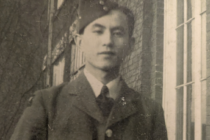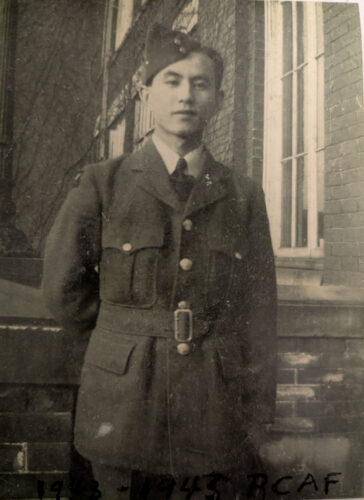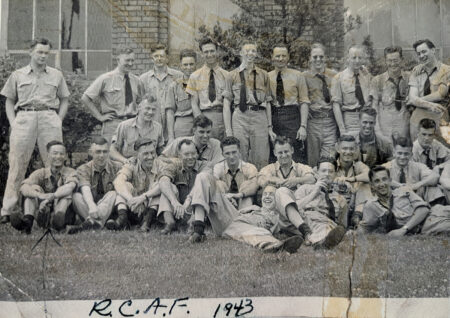
Glen Wong was born in 1924 in Vancouver, BC. During the Second World War, Glen voluntarily served in the Royal Canadian Air Force from 1943 to 1945 as a Wireless (radio) operator. He was based at the Manning Depot No. 2 in Brandon, Manitoba. He also travelled to other parts of Canada during his service, including Kingston, Ontario and Victoriaville, Quebec.
Glen shared many stories with his grandson, Dr. Christopher Au-Yeung, of his memories just before and during the war period. The earliest story was when Glen was just a 13-year-old boy and was traumatized when he narrowly escaped death just prior to the Nanking Massacre in 1937. After that harrowing experience, Glen vowed to fight the Japanese. Years later he described to his grandson how the decimated, underequipped Chinese army hid in the fog-laden rice paddies, ambushing unsuspecting Japanese soldiers with their knives in hand-to-hand combat.
Glen also shared with his grandson that he wanted to join the air force, rather than the army or navy, because he believed the air force was more ‘gentlemanly.’ Unfortunately, at the time, Chinese were not accepted directly into the RCAF so Glen had to enlist in the army first, then ask for a transfer into the air force. Getting accepted into the air force also required that Glen had a reference letter.
Glen had graduated from Biggar Central High School, in Biggar Saskatchewan. So, for his reference letter, Glen turned to his former Physics and Math teacher, Mr. Woodrow Lloyd who gave the young man a glowing recommendation. Mr. Lloyd would later become Saskatchewan’s premier.
When Glen tried to sign up while living in Biggar, Saskatchewan he was told he needed to return to British Columbia, his home province, in order to enlist. Also, once transferred to the RCAF, Glen was given only two options for his training because he was so slight in stature: either become a tail gunner, which he was told had a 90% casualty rate or do wireless. Glen chose the latter!
During basic military training, daily marches consisted of a drill sergeant barking out orders to the soldiers to march in unison. Everyone except Glen was in step. The sergeant yelled, “Wong, quit rocking the boat!” During rifle marksmanship training, Glen only scored 70 out of 100 because he wore corrective lenses most of his life. Regular proper grooming was enforced in RCAF, and Glen was directed by his superiors to get a haircut every week. To the barber’s dismay, he grumbled that Glen’s hair was always black no matter how short he cut it each time. The barber told Glen’s superiors that he didn’t need a haircut that frequently.
As a wireless operator, Glen recalled working with huge tower stacks of radio tube electronics, which was cutting edge technology at the time. As well, one time while on a RCAF base, Glen was sent to guard the wreckage of a plane that had crashed and killed the pilot during training. Glen told his grandson he was ordered to shoot anything that came near it during recurrent overnight watch shifts which lasted 2 hours at a time.
Glen stood out amongst his fellow recruits because, at one point, he was the only Chinese Canadian soldier on the base.
Cheryl Au-Yeung, Glen’s daughter, recalled “My father was always grateful that the war ended after the Americans dropped the atomic bombs on Japan. He knew it was only a matter of time before he’d be sent to Burma to fight the Japanese. After the war, it was a priority for my father to find a wife. It was a classic pen-pal romance with my late mother, Daisy Lam, whom he met in Hong Kong.”
Glen had a career with the government and he and Daisy would raise three daughters.
He passed away peacefully at Vancouver’s Mount St. Joseph hospital in 2016 at the age of 91.

Glen standing proudly in his RCAF uniform.

Glen, second from right, with friends Frank Wing (far left) and Herby Chan (far right). Photo taken on Pacific Avenue in Winnipeg during the Second World War.

Glen (front row far left) with his fellow RCAF recruits in 1943. At one point he was the only Chinese Canadian on the base.